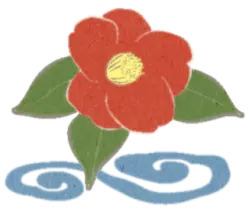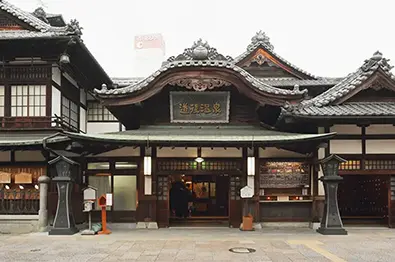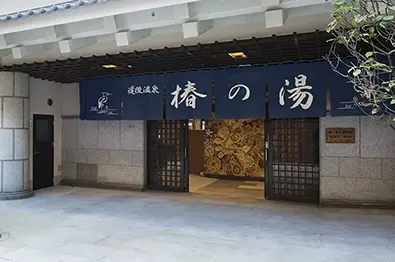



-
Dōgo Onsen Honkan+

-
Asuka-no-Yu+

-
Tsubaki-no-Yu+

Dōdo Onsen Video Page
Dōgo Onsen Front Page > Dōdo Onsen Video Page
Dogo Onsen Video List Page
Waiting for you at the three bathhouses.
“Onsen Dialogue” PR video of the three Dogo Onsen bathhouses
Dogo Onsen has three bathhouses: the main building called Honkan and the annex Asuka-no-Yu, which is a base for spreading new onsen culture, and Tsubaki-no-Yu, which continues to be loved by the locals.
In the PR video “Onsen Dialogue,” Matsuyama Mayor Noshi performs rakugo, traditional Japanese comic storytelling, to introduce the charm and characteristics of each of the three unique bathhouses of Dogo Onsen.
How do you want to enjoy the triple-threat of Dogo Onsen?
Don’t let the deep history and culture of Dogo Onsen leave you light-headed.
We hope you’ll so satisfied that you’ll say, “Dogo is really “DOing GOoood!”
Add the fun of choosing to the joy of bathing.
Waiting for you at the three bathhouses. Dogo Onsen
“Onsen Dialogue” 6-second trailer
“Onsen Dialogue” 15-second trailer
“Onsen Dialogue” 30-second trailer
“Onsen Dialogue” making-of video
Three Dogo Onsen bathhouses PR Video “Dogo Waltz”
Dogo Onsen has three bathhouses: the main building called Honkan and the annex Asuka-no-Yu, which is a base for spreading new onsen culture, and Tsubaki-no-Yu, which continues to be loved by the locals.
The PR video “Dogo Waltz,” featuring entertainer and Matsuyama native Tomochika, introduces repeatedly the charm of the three bathhouses, each of which presents a different face of Dogo Onsen.
How do you want to enjoy the triple-threat of Dogo Onsen?
Don’t let the deep history and culture of Dogo Onsen leave you light-headed.
We hope you’ll so satisfied that you’ll say, “Dogo is really “DOing GOoood!”
Add the fun of choosing to the joy of bathing.
Waiting for you at the three bathhouses. Dogo Onsen
Dogo Onsen Art 2022
Dogo Onsen Art 2022 PR movie
A PR movie was made for “Dogo Onsen Art 2022,” in which you see art works around the town, Dogo Onsen Honkan, back alleys of the Dogo shopping Arcade, and people enjoying footbaths and handbaths.
Dogo Onsen Honkan Conservation and Repair Work
Scenes from Dogo Onsen Honkan Conservation and Repair Work
“Connecting History to the Future" Vol. 9 (August 2023)
This video introduces the repair status of the roof work during the Dōgo Onsen Honkan conservation and repair work and commentary from the person in charge of the actual measurement survey.
Scenes from Dogo Onsen Honkan Conservation and Repair Work
“Connecting History to the Future" Vol. 8 (March 2023)
This video provides an overview of the construction work done to prevent collapse, as well as the inspection and examination of the roof tiles that were removed during the demolition.
Scenes from Dogo Onsen Honkan Conservation and Repair Work
“Connecting History to the Future” Vol. 7 (August 2022)
This video shows the state of the construction platform above the roof when the work shifted from the early phase to the later. It also explains the demolition work on the Kami-no-Yu bath.
Scenes from Dogo Onsen Honkan Conservation and Repair Work
“Connecting History to the Future” Vol. 6 (January 2022)
Viewing of the Yūshinden began on January 20, 2022, after conservation and repair work was completed. This video shows how work was carried out in the Yūshinden.
Scenes from Dogo Onsen Honkan Conservation and Repair Work
“Connecting History to the Future” Vol. 5 (July 2021)
The first half of the conservation and repair work of Dogo Onsen Honkan, begun in January 2019, has been completed. This video shows how to make plaster and how the plastering was carried out in the south wing.
Scenes from Dogo Onsen Honkan Conservation and Repair Work
“Connecting History to the Future” Vol. 4 (March 2021)
The Yūshinden in the Tama-no-Yu wing has the only bath in Japan dedicated to the imperial family. Its paper screens, or shoji , and mural paintings covered with gold and silver leaf were repaired by special craftsmen in Kyoto. This video focuses on metal knobs being repaired.
Scenes from Dogo Onsen Honkan Conservation and Repair Work
“Connecting History to the Future” Vol. 3 (July 2020)
The roofs of the Yūshinden in the Tama-no-Yu wing and those of the south wing were replaced. This video spotlights the roof tiles of the south wing, which are Kikuma tiles, a designated Ehime Prefecture Traditional Product.
Scenes from Dogo Onsen Honkan Conservation and Repair Work
“Connecting History to the Future” Vol. 2 (March 2020)
The drainage pipes are buried deep into the ground under the central corridor, which is the heart of Dogo Onsen Honkan. During the conservation and repair work, excavation was carried out to renovate the pipes. This video focuses on ceramic pipes used for drainage.
Scenes from Dogo Onsen Honkan Conservation and Repair Work
“Connecting History to the Future” Vol. 1 (August 2019)
The conservation and repair work of Dogo Onsen Honkan began on January 15, 2019. This was the first time in Japan that renovation work was done while the bathhouse remained in operation. A construction framework was installed for the roof replacement work. This video spotlights the framework for protecting the building from rain or wind.
Sightseeing videos
“Yo oidetanamoshi!” Welcome to Dogo Onsen Annex Asuka-no-Yu!
Dogo Onsen is said to be the oldest hot spring in Japan.
In December 2017, the new hot spring facility Dogo Onsen Annex Asuka-no-Yu celebrated its grand opening. ♨
Take a virtual trip to Asuka-no-Yu, where you can enjoy stories about the history of Dogo Onsen and the contentment of soaking in a hot spring. Join the young lady travelers and enjoy the charm of Dogo Onsen with the 360°video.
Immerse yourself in a virtual trip with your smartphone or tablet. ♪
Image of Matsuyama charms Dogo Onsen Annex Asuka-no-Yu
Asuka-no-Yu is introduced in a visual broadcast showing the charms of Matsuyama City.
The video condenses highlights of Asuka-no-Yu with its largeresting hall and private rooms such as Shirasagi-no-Ma, Tamanoishi-no-Ma, Tsubaki-no-Ma, Karimiya-no-Ma, and Yugeta-no-Ma. In addition, there are the large public bath surrounded by wall murals, the open-air bath, and the special bathing room, Yūshinden, that replicates the private bath made exclusively for the imperial family at Dogo Onsen Honkan.
Orche(oke)stra
A symphony orchestra welcomes visitors with the majestic notes of Viennese waltz set in Dogo Onsen, mixed with the soothing resonance of wooden oke buckets – a familiar onsen sound.
Recovery support video "That time, in Ehime." Dogo Onsen
In July 2018, Ehime Prefecture suffered tremendous damage due to record-breaking rainfall.
Life has gone on as we continue to recover little by little.
Be honest, be cheerful, be positive, with friendly smiles and warm feelings.
We are waiting to present you with Ehime as it is now.
If you would like to relax on your next vacation, then, at that time, be in Ehime.
Dogo Time Exploration
Dogo Time Exploration Omnibus
Dogo Time Exploration is the title of Dogo Onsen’s time-themed walking tours.
The Tokidaiko Drum at Dogo Onsen Honkan is struck three times a day to tell the time. The sound of the taiko drum has been selected as one of the 100 Soundscapes of Japan Worth Preserving.
Step outside Dogo Onsen Honkan to experience the culture of public bathhouses at Asuka-no-Yu and Tsubaki-no-Yu and enjoy a stroll wearing a yukata. After you visit the classic Botchan Karakuri Clock, explore the temples and shrines, go for a walk in the natural richness of Dogo-Koen Park, and experience the hot spring source with your all five senses. This town, showing different faces over time, is what makes Dogo Onsen so special.
Dogo Time Exploration vol. 1 Dogo Onsen Annex Asuka-no-Yu
Go straight from Dogo Onsen Honkan through Dogo Shopping Arcade and you will soon see Asuka-no-Yu. The bathhouse, with integrated architectural styles of the Asuka period, is decorated in a combination of Ehime’s traditional arts and crafts and resembles a museum. Along with a bath, you can choose a course with a relaxation room. Take a bath in the special room that is a replica of the imperial Yūshinden bath in the Dogo Onsen Honkan, and wear a yukata as you savor green tea and cakes afterwards. Take a break from your daily routine and enjoy the traditional hospitality of Dogo Onsen.
Dogo Time Exploration vol.2 Dogo Onsen Tsubaki-no-Yu
The Dogo Onsen Experience is not complete without shopping and dining as you stroll through the Dogo Shopping Arcade in a yukata after stepping off the tram at Dogo Onsen Station.
As the Arcade turns toward Dogo Onsen Honkan, you will see Tsubaki-no-Yu on your left. Tsubaki-no-Yu is the town bathhouse loved by locals.
Make yourself at home and let the spacious atmosphere relieve your tired body as you relax. As one pleasure among others, why not enjoy taking a walk after your bath in search of the onsen manhole covers?
Dogo Time Exploration vol. 3 Dogo Onsen No. 4 Hot Spring Supply Facility
The Hot Spring Supply Facilities draw spring water from the source of Dogo Onsen and distribute it to public baths such as in Dogo Onsen Honkan and hotels.
The characteristic feature of Dogo Onsen is that it is a free-flowing hot spring with the temperature adjusted by mixing hot springs of different temperatures, without heating or adding water. Walk along keeping Dogo Onsen Station on your left and you will find the No. 4 Hot Spring Supply Facility. At the facility you can watch the procedure for free and feel the freshly pumped hot spring water in the handbath. Stop at the quaint promenade Nikitatsu-no-Michi Street nearby or, for a change of pace, enjoy strolling the back streets of Dogo Onsen.
Dogo Time Exploration vol. 4 Sora-no-Sanpomichi(sky promenade & footbath)
Find Sora-no-Sanpomichi(sky promenade & footbath) on the slightly elevated Mt. Kanmuriyama near Dogo Onsen Honkan. Visit the Yu-jinja Shrine, closely related to Dogo Onsen and soak your tired feet in the footbath as you take in the majestic town view of the Dogo Onsen slowly colored in the glow of the sunset. Notice the time changing as the lights start to come on.
Dogo Time Exploration vol. 5 Botchan Karakuri Clock
When you get off the Botchan Train at Dogo Onsen Station, you will see the Botchan Karakuri Clock in front of you. Watch the joyful movement of the figures in the clock before heading into the town of Dogo Onsen. Soak your feet in a footbath, go for an auspicious tour of Enman-ji and Hogon-ji Temples, and enjoy a special walk that only Dogo Onsen can offer. Also, be sure to take in the unique hot spring ambience at night, when Dogo Onsen shows a different appeal from its daytime presence.
Hogon-ji Temple has suspended the distribution of sharigami paper talismans in order to prevent the spread of COVID 19 infection. For the latest information, please visit the Dogo Onsen Auspicious Tour website (https://dogo-kaiunmeguri.info).
Dogo Time Exploration vol.6 Dogo-koen Park
The lush green Dogo-koen Park that you can see from Dogo Onsen Station is a place where you can fully enjoy the four seasons and nature of Japan, with water lily pond and an observatory. Feel the history and culture of Dogo Onsen at the Yuzuki Castle Ruins where samurai lived, and the Shiki Museum, which traces the footsteps of Masaoka Shiki, father of modern haiku. At the end of your town walk, visit the Isaniwa-jinja Shrine, an important cultural property known as one of Japan’s three examples of Hachimanzukuri architecture, for a spectacular sunset from the top of the shrine’s stone steps.








